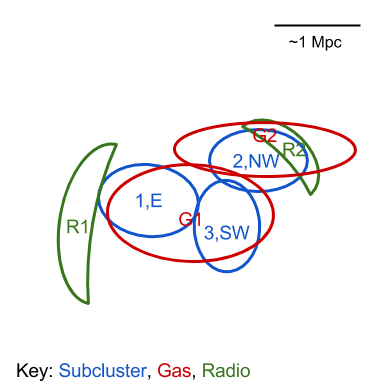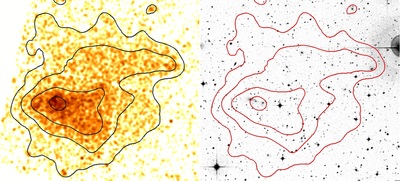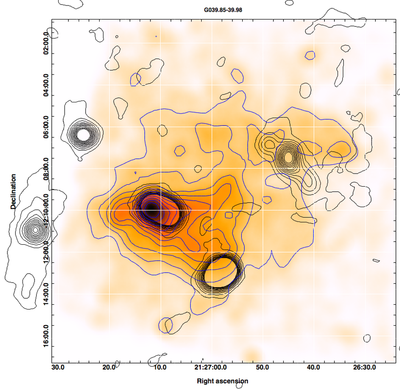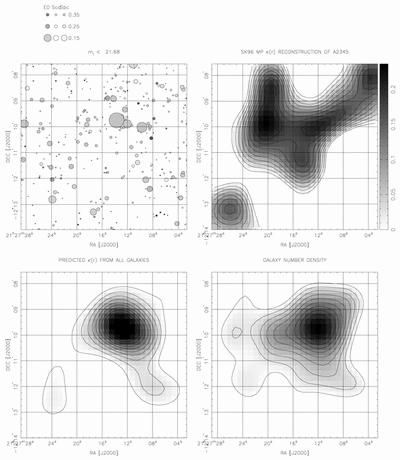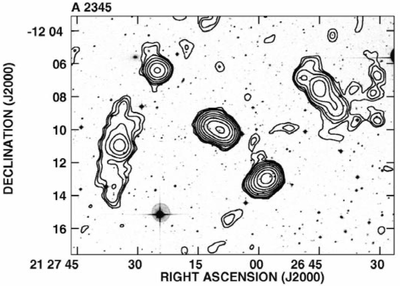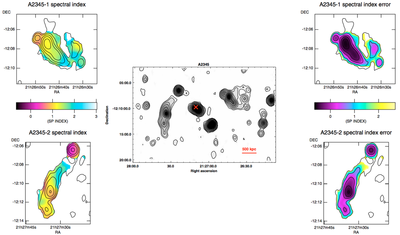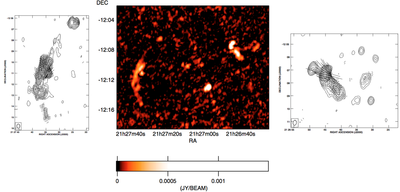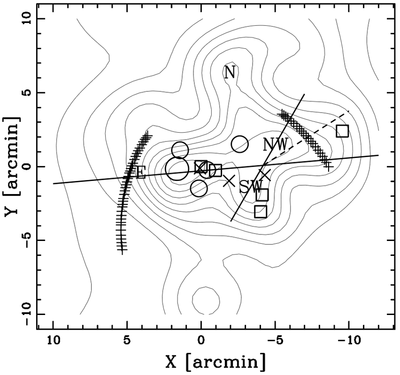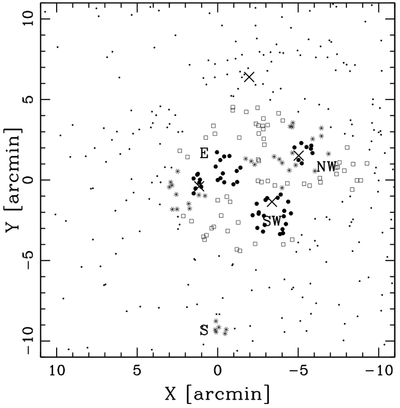Abell 2345
| RA | Dec | z |
|---|---|---|
| 21:27:11.0 | -12:09:33 | 0.179 |
Summary
Dahle et al. (2002) performed an optical and weak lensing analysis of Abell 2345 finding that the luminosity and number density distributions of galaxies are have a peak near the "well-defined core" that is dominated by a cD galaxy. However, they note that archival ROSAT X-ray images show a large amount of substructure and suggest that this is evidence that the cluster may be in a dynamically young state. They do find that the highest peak in their weak lensing map is offset east of the cD galaxy by ~1.5', but that a secondary peak in much closer to the cD galaxy. Note that the Dahle et al. (2002) analysis does not cover the NW and SW peaks identified by Boschin et al. (2010). Cypriano et al. (2004) also estimated the mass of the system via weak lensing but did not discuss A2345 in detail.
Giovannini et al. (1999) were the first to identify A2345 as a radio relic cluster in NVSS, identifying two extended sources and making it the second double relic system discovered (the first being A3667, Rottgering et al. 1997). Bonafede et al. (2009) confirmed the presence of the two relics with VLA observations at 325 MHz and 1.4 GHz. They note several discrete radio sources near the western relic, but none are expected to produce diffuse radio emission. They estimated average spectral index values of 1.5+/-0.1 and 1.3+/-0.1 for the eastern and western relics, respectively. Bonafede et al. (2009) also measured a mean fractional polarizations of ~14% and ~22% (with values up to ~55%) for the eastern and western relics, respectively. Bonafede et al. (2009) also studied the ROSAT X-ray image of the system and found that the NW-SE elongation fit the radio relic picture. They also make a rough calculation based on the approximate Mach number that the collision velocity was ~1200 km/s and the merger occurred ~0.4 Gyr.
Boschin et al. (2010) conducted a thorough redshift analysis of the system using 98 cluster member redshifts. They claim that there are three separate subclusters (E, NW, SW), based on their photometric and spectroscopic analysis. With the NW and SW subclusters having similar mean velocities but an ~800 km/s velocity difference compared to the E subcluster. They claim that the NW-SW subcluster axis is a natural explanation for the western relic while the E-NW-SW subcluster axis roughly coincides with eastern relic. However that note that if this is the case it is perhaps surprising that there is not a third relic in the south. Boschin et al. (2010) estimate the system mass to be ~2e15 M_sun, but they admit that it is difficult to estimate the mass of the system with galaxy velocities due to the close proximity of the subclusters in projected and redshift space. They also performed a rough timing argument dynamics analysis of the two possible mergers. For the E and NW+SW they argue that merger axis is α~40 degrees with respect to the plane of the sky, and is ~0.35 Gyr since they collided with a velocity of ~2000-2800 km/s. For the NW-SW scenario they estimate that the merger axis is α~2-20 degrees and that they collided ~0.2 Gyr ago with a velocity of ~300-1400 km/s. This dynamic analysis should be considered a very rough estimate since the system is not well suited to the assumptions implicit with the timing argument (e.g. since it is a multi-modal system, with overlapping halos).
Giovannini et al. (1999) were the first to identify A2345 as a radio relic cluster in NVSS, identifying two extended sources and making it the second double relic system discovered (the first being A3667, Rottgering et al. 1997). Bonafede et al. (2009) confirmed the presence of the two relics with VLA observations at 325 MHz and 1.4 GHz. They note several discrete radio sources near the western relic, but none are expected to produce diffuse radio emission. They estimated average spectral index values of 1.5+/-0.1 and 1.3+/-0.1 for the eastern and western relics, respectively. Bonafede et al. (2009) also measured a mean fractional polarizations of ~14% and ~22% (with values up to ~55%) for the eastern and western relics, respectively. Bonafede et al. (2009) also studied the ROSAT X-ray image of the system and found that the NW-SE elongation fit the radio relic picture. They also make a rough calculation based on the approximate Mach number that the collision velocity was ~1200 km/s and the merger occurred ~0.4 Gyr.
Boschin et al. (2010) conducted a thorough redshift analysis of the system using 98 cluster member redshifts. They claim that there are three separate subclusters (E, NW, SW), based on their photometric and spectroscopic analysis. With the NW and SW subclusters having similar mean velocities but an ~800 km/s velocity difference compared to the E subcluster. They claim that the NW-SW subcluster axis is a natural explanation for the western relic while the E-NW-SW subcluster axis roughly coincides with eastern relic. However that note that if this is the case it is perhaps surprising that there is not a third relic in the south. Boschin et al. (2010) estimate the system mass to be ~2e15 M_sun, but they admit that it is difficult to estimate the mass of the system with galaxy velocities due to the close proximity of the subclusters in projected and redshift space. They also performed a rough timing argument dynamics analysis of the two possible mergers. For the E and NW+SW they argue that merger axis is α~40 degrees with respect to the plane of the sky, and is ~0.35 Gyr since they collided with a velocity of ~2000-2800 km/s. For the NW-SW scenario they estimate that the merger axis is α~2-20 degrees and that they collided ~0.2 Gyr ago with a velocity of ~300-1400 km/s. This dynamic analysis should be considered a very rough estimate since the system is not well suited to the assumptions implicit with the timing argument (e.g. since it is a multi-modal system, with overlapping halos).
Existing Data
|
Optical Imaging
|
Spectra
|
X-ray
|
Radio
|
Gallery
References
- Giovannini, G., Tordi, M. & Feretti, L., 1999. Radio halo and relic candidates from the NRAO VLA Sky Survey. New Astronomy, 4(2), pp.141–155.
- Dahle, H. et al., 2002. Weak Gravitational Lensing by a Sample of X‐Ray Luminous Clusters of Galaxies. I. The Data Set. The Astrophysical Journal Supplement Series, 139(2), pp.313–368.
- Cypriano, E. S., Sodre, L., Jr, Kneib, J.-P., & Campusano, L. E. (2004). Weak‐Lensing Mass Distributions for 24 X‐Ray Abell Clusters. The Astrophysical Journal, 613(1), 95–108.
- Bonafede, A., Giovannini, G., Feretti, L., Govoni, F., & Murgia, M. (2009). Double relics in Abell 2345 and Abell 1240. Astronomy and Astrophysics, 494(2), 429–442.
- Boschin, W., Barrena, R., & Girardi, M. (2010). The complex structure of Abell 2345: a galaxy cluster with non-symmetric radio relics. Astronomy and Astrophysics, 521, 78.
- Chandra-Planck Legacy Program for Massive Clusters of Galaxies website
* Lensing quality imaging
^ Galaxies with spectroscopic redshifts near the cluster within a radius of 2 Mpc of the system center.
^ Galaxies with spectroscopic redshifts near the cluster within a radius of 2 Mpc of the system center.

